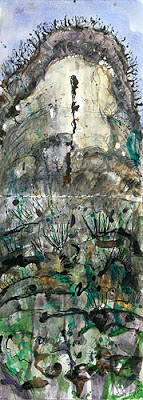double spread A5 sketchbook
© The Artist.
Detail :note I’m using a roller ball pen by 2004 & saving the ‘spider-webs’ of nib for the really important bits.
If you follow the ‘crack’ or the stain down you arrive at the level at which there was once an underground river, which formed an underground gallery going back quiet so way through the rock but having deposited a fair bit of soil etc upon it’s retreat. It is now dry.
Follow the crack down & go up and into gallery…
I love that ladder! Not at all like the modern day museum trappings of book shop, postcards & disgruntled ticket salespersons.
Go into the labyrinth to meet your monster…
….. who is the crowning glory of late Prehistoric Cave Art (whoops, sorry we aren’t allowed to call it ‘art’ any more according to some archeologists 😉 It’s some 15 000 years on from the ‘western european creative explosion’ of Chauvet…
…isn’t he just the most finest of beasts!
History of Font de Gaume
Prehistoric people living in the Dordogne Valley first settled in the mouth of Font de Gaume around 25,000 BC. The cave mouth was inhabited at least sporadically for the next several thousand years. However, after the original prehistoric inhabitants left, the cave was forgotten until the nineteenth century when local people again began to visit the cave.
In 1901, Denis Peyrony, a school teacher from Les Eyzies, discovered the paintings inside Font de Gaume. The paintings date from around 17000 BC, during the Magdalénien period. However, many of the cave’s paintings were discovered much later. The cave’s most famous painting, a frieze of five bison was discovered accidentally in 1966 while scientists were cleaning the cave.





